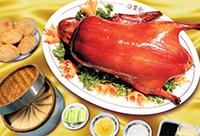| |
Beijing, the capital of China, is one of the world's famous historical and cultural cities. As a city with more than 3,000 years of recorded history, Beijing served as the capital of five dynasties including Liao, Jin, Yuan, Ming and Qing for about 800 years. On Oct 1,1949, when the People's Republic of China was established, Beijing once again became the newborn capital of China.
In the city, cultural heritage sites and scenic spots could be found everywhere, including the Forbidden City, the Great Wall, the Zhoukoudian Site, the Temple of Heaven, the Summer Palace and the Ming Tombs, all of which have been put on the list of the UNESCO World Heritage Sites. By 2011, there are 162 museums and 4,300,000 heritage collections in Beijing attracting 35 million visitors.
Typicall features of Beijing
The Palace museum

Located in the center of Beijing, the Palace Museum, historically and artistically one of the most comprehensive museum in China, was established on the basis of the Forbidden City, a palace of the Ming and Qing dynasties (1368-1840), and their collection of treasures.Being called The Forbidden City historically, it used to be the imperial palace of the Ming and Qing dynasties. It is nearly 600 years old, with construction started in 1406 and completed in 1420. The principles of Feng Shui, the ancient Chinese system of geomancy, governed the whole process. The rectangular palace covers an area of some 720,000 sq. km -- 961 m in length and 760 m in width. It has a total of 9999.5 room spaces (an area enclosed by four poles). In 1924, the imperial family of the Qing Dynasty (1644-1840) was removed from the Forbidden City, and in 1925 the Palace Museum was established here.
Beijing Opera

Beijing Opera, the Chinese artistic treasure with nearly 200 years of history, is highly reputed as the 'quintessence of China' by its infinite artistic charm. It is the very popular and most representational and outstanding opera of all the Chinese traditional dramas. It is the richest in the list of plays, finest on its performance and the most widespread on popularity, deeply admired and loved by local people and even its universal audience.
Hutong

The thoroughfare is the sign of Beijing, but an equally important symbol is its Hutongs which proliferate in this city. Walking around this modern city, most visitors are not as interested in the tall buildings and wide streets extending in all directions as they are in the small winding and profound Hutongs. These are ancient city alleys with their residences so characteristic of Beijing.
Siheyuan, a courtyard home surrounded by rooms on all four sides

The siheyuan is a typical form of ancient Chinese architecture, especially in the north of China.They are designed to make it as comfortable as possible to live in a climate that is at times inhospitable.It is normal for the four rooms to be positioned along the north-south, east-west axes. The room positioned to the north and facing the south is considered the main house and would traditionally have accomodated the head of the family. The rooms adjoining the main house are called " side houses" and were the quarters of the younger generations or less important members of the family.
Peking duck

Peking duck is a famous duck dish from Beijing[1] that has been prepared since the imperial era, and is now considered a national dish of China.The dish is prized for the thin, crisp skin, with authentic versions of the dish serving mostly the skin and little meat, sliced in front of the diners by the cook. Ducks bred specially for the dish are slaughtered after 65 days and seasoned before being roasted in a closed or hung oven. The meat is eaten with pancakes, scallion, and hoisin sauce or sweet bean sauce.Two notable restaurants in Beijing which serve this dish are Quanjude and Bianyifang, two centuries-old establishments which have become household names.Quanjude is known for using the hung oven roasting method, while Bianyifang uses closed oven roasting.
|
|
